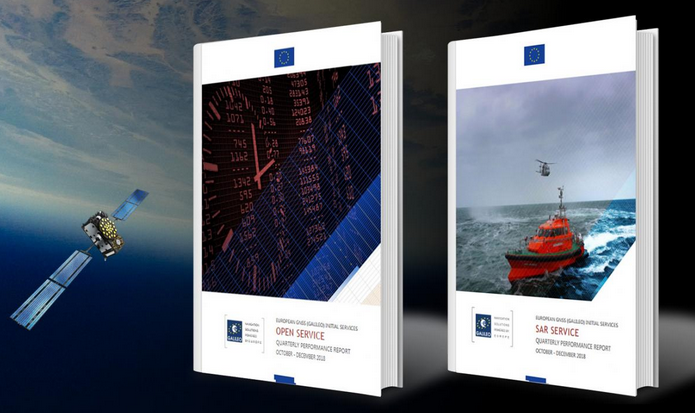The Galileo Open Service (OS) and the Enhanced Search and Rescue (SAR)/Galileo Service Performance Reports of the second quarter of 2022 (covering April, May, and June 2022) are available at the Electronic Library of the European GNSS Service Centre web portal.

The Galileo OS and SAR/Galileo Service Public Performance Reports for the second quarter of 2022 are available in the Performance Reports section, providing the status of the Galileo constellation and the achieved performance over the second quarter.
These quarterly reports provide users with the latest information on the Galileo OS and SAR/Galileo measured performance statistics with respect to their Minimum Performance Levels (MPLs), as defined in their respective Galileo Service Definition Documents: OS-SDD and SAR-SDD. Both SDDs can be found in the Programme Reference Documents section of the GSC web portal.
The quarterly reports provide information to users on parameters such as:
- For Galileo OS: Ranging Performance, Galileo UTC and Galileo-GPS Time Offset (GGTO) Dissemination and Determination Performance, Galileo Positioning
Performance, the Timely Publication of NAGUs, …
- For SAR/Galileo Enhanced Services: Forward Link Service, Detection and Location Performance, Return Link Service, Return Link Message (RLM) Delivery Latency and Reception Probability Performance, European MEOLUT and Space Segment Availability Performance, …
Highlights from Q2-2022 Public Performance Reports:
As in previous periods, the Galileo measured OS and SAR Service performance figures exceeded their MPL thresholds, specified in the OS-SDD and SAR-SDD.
Some highlights from the Q2-2022 performance reports:
Open Service:
- Galileo Open Service Ranging Performance:
- Per-slot Availability of Healthy Signal in Space for each Galileo operational satellite: average monthly values at least equal to 97.97% for every Single-Frequency and Dual-Frequency combination, considerably above the MPL threshold (92%).
- Galileo Signal in Space Ranging Accuracy for individual space vehicles: monthly accuracy between 0.24 [m] and 2.5 [m] on Single-Frequency observables. For Dual-Frequency combinations, the figure in the range of 0.15 [m] to 0.38 [m]. Compliance with the MPL (threshold is 7 [m]) achieved with considerable margins by all satellites of the Galileo constellation.
- Average Ranging Accuracy at constellation level (over “All Satellites”): figures “per signal” better than or equal to 0.57 [m] for Single-Frequency signals and 0.16 [m] for Dual-Frequency signal combinations. Achieved results almost one order of magnitude better than the MPL threshold (2 [m]).
- Galileo UTC and GGTO Dissemination and Determination Performance: good values achieved for the UTC Time Dissemination Service Accuracy, the UTC Frequency Dissemination Service Accuracy, and the GGTO Determination Accuracy.
- Galileo Positioning Performance: availability of both Position Dilution of Precision (PDOP) and Positioning Service target values met with a large margin.
- Timely Publication of NAGUs (Notice Advisory to Galileo Users): during the quarter 14 NAGUs issued in the reporting period, respecting the requirements for their timeliness (target to issue a NAGU at least 48 hours before the start of a scheduled event, as well as not more than 30 hours after an unscheduled one).
Enhanced SAR/Galileo Service:
- Availability of SAR/Galileo:
- Forward Link Service: exceeded 99% each month of the reported period and the annually normalised value since January 2022 achieved 99.9% in June (above defined MPL of 99%).
- MEOLUT facilities in “Nominal” and “Nominal + Degraded” modes: remains at excellent levels, with annually normalised values in June better than 99.0% and 99.5% respectively, always above the MPL targets of 95% in “Nominal” and 97.5% in “Nominal + Degraded” modes.
- Return Link Service: was 99.88% in April and 100% in May and June (MPL set to 95%).
- SAR Transponders: achieved excellent levels of performance reaching monthly satellite transponder availability above 95.37% during the reported period (MPL set to 95%).
- Performance of:
- Detection Service: above expectations, with monthly values of a valid message detection probability after a single transmitted burst of 99.9% or 100% (MPL target is 99%).
- Location Probability: excellent values achieved, with monthly values higher than 99.3% for a single burst (MPL target is 90%), and 99.9% after 12 transmitted bursts (multi-burst) (MPL target is 98%).
- Location Accuracy: surpassed the targets; monthly values higher than 98.6% for a single burst and 99.8% for multi-burst transmissions with accuracy better than 5 km, while the MPLs are 90% and 95% respectively.
- Return Link Service:
- Delivery Latency within 15 min: above 99.98% and at 99.99% on average over the reported period (MPL set to 99%).
- Reception Probability: 100% in April and May, and 99.95% in June (MPL set to 99%).
For the most up-to-date information on the Galileo system and constellation, visit the European GNSS Service Centre (GSC) website, in particular, the Galileo constellation status section. For an exhaustive description of the Minimum Performance Levels (MPLs), refer to the SDDs (Programme Reference documents).
For more details on Galileo performance and its services, do not hesitate to contact the Galileo Help Desk. Moreover, if you wish to receive NAGUs and notifications of new Galileo publications, please register to the GSC web portal and subscribe to our newsletters.
Media note: This feature can be republished without charge provided the European Union Agency for the Space Programme (EUSPA) is acknowledged as the source at the top or the bottom of the story. You must request permission before you use any of the photographs on the site. If you republish, we would be grateful if you could link back to the EUSPA website (http://www.euspa.europa.eu).